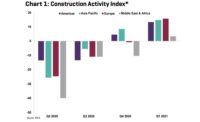While pursuing an ecology doctorate at the Spanish National Museum of Natural History, Aurora Torres was thinking about infrastructure and sprawl. But what ultimately focused her attention was hearing about a beach in Jamaica that had been stolen.
The story of the plundered beach, along with criminal commodity cabals in India and Italy, Morocco and Mauritius, China and Vietnam, have become symbols of an issue facing the industry: the precarious state of the global sand supply.
Sand and aggregate are prime materials for asphalt, glass and concrete. If sand were to run short—or if its supply became unpredictable—it would severely impact the industry. Sand scarcity may be complex, but there are enough warning signals to warrant attention. In February, the United Nations Environmental Program published a report on sand and sustainability. “Shifting consumption patterns, growing populations, increasing urbanization and infrastructure development have increased demand threefold over the last two decades. We now need 50 billion tonnes per year, an average of 18 kg per person per day,” acting UNEP executive director Joyce Msuya wrote. “We have been exceeding easily available sand resources at a growing rate for decades.”
Danish researchers and a Greenland government minister are exploring whether the massive island can become a sand exporter as its glaciers melt and release fine crushed sand into its waterways, as reported in The New York Times and Germany’s Der Spiegel.
Accelerating Demand Strains Supplies
Sand and gravel are by far the world’s most extracted materials, and extraction is going to double in the coming decades, according to the Organization for Economic Cooperation and Development.
This doesn’t mean the world as a whole is running out of sand. But there are more interconnected ecological and economic forces at work. Torres, now a postdoctoral fellow at the German Center for Integrative Biodiversity Research in Leipzig, will soon to begin a research effort at Michigan State University and the University Catholique of Louvain to study sand mining. She says skyrocketing demand for sand drives shortages in many regions.
It’s this rising demand—from dozens of emerging megacities, millions of miles of roads, masses of populations moving to urban areas—that has Torres concerned. She and her colleagues are trying to get this message out, without getting muddled in debates about the total supply of sand.
“The statement that there is a global scarcity of sand is unsupported,” she says. “This crisis is more about the implications that the over-excavating of sand and gravel deposits is going to have on humans and the environment.” There’s still a lot of sand in the world, and nature makes more construction sand—angular shaped, quartz-silica, concrete-ready—all the time. But it’s usually a local resource. It doesn’t make economic sense to transport sand more than about 50 miles.
The world’s vast deserts don’t factor in the equation, experts tell ENR. Desert sand is no good for concrete: the shifting winds of the Sahara and Gobi render the grains too smooth to use. Oil-rich countries like the United Arab Emirates or Qatar import Australian sand by the shipload for construction. But not all nations can afford to do so. “Concentrated economic development, population growth, urbanization, infrastructure development—these lead to highly localized demand for materials that in some cases exceeds original supply,” Torres says. “It creates a shortage. In many cases, local scarcity is not physical. It might be a consequence of economic constraints.”
The situation led the OECD and UNEP to call for better oversight. “Despite the colossal quantities of sand and gravel being used, our increasing dependence on them and the significant impact that their extraction has on the environment, this issue has been mostly ignored by policy makers and remains largely unknown by the general public,” UNEP science director Pascal Peduzzi wrote in 2014. UNEP’s Msuya is more forthright. “Sand is being produced through environmentally damaging extractive practices in sensitive terrestrial, riverine and ocean ecosystems,” she wrote in the report. It’s hard to balance the health of ecosystems against construction in many regions. “We need to reconcile relevant global policies and standards with local sand availability, development imperatives and standards and enforcement realities.”
Recycling Seen as Possibility for Local Shortages
Industry firms have mixed opinions. Reporter Vincent Beiser has written about sand demand and scarcities for years, resulting in his 2018 book, “The World in a Grain of Sand.” As he prepared to publish the book, U.S. concrete trade associations moved to rebut his findings. “The author alleges that our country is running out of sand, which is false,” Michael W. Johnson, head of the U.S. National Stone, Sand and Gravel Association, told Quarry magazine. He instead noted delays in bringing new quarries online. “Our infrastructure needs, and the lack of federal support, are worrisome, not the availability of sand.” The association declined to comment to ENR.
Swiss-based concrete giant LafargeHolcim has worked out a multipronged plan, including networks for manufactured and recycled sands. “We’re aware of the growing scarcity of natural sand in certain regions of the world, driven by geological constraints and increasing legislative and permitting requirements,” says Jan Hoffmann, LafargeHolcim’s head of business excellence. “Aggregates is a very local business, so it is important to look at each market individually. There are significant regional differences in the availability of natural sand.”
LafargeHolcim aims to use 88 million tons of resources made from waste in its products each year. Hoffmann says securing less environmentally sensitive aggregate reserves is a priority. “Establishing hard rock reserves during the early stages of local market sand substitution is key to our reserve-management strategies.”
Northern Ireland-based equipment manufacturer CDE recently introduced an all-in-one wet-processing system to produce manufactured sand. The Combo is a portable sand-washing and water-recycling plant that can process 30 to 200 metric tons per hour, washing crushed rock fines and waste quarry to produce sand. CDE got into the material recycling business in the early 2000s as natural sand deposits became harder to find in the greater London area, says Kevin Vallelly, CDE’s director of engineering.
Paul Holroyd, CDE’s head of sand and aggregates, says demand for materials and uneven supplies of industrial sand creates business openings for manufactured and recycled sand. India’s largest state, Rajasthan, has banned sand mining. Local governments in India, including Mumbai, moved to restrict mining sand along rivers. This prompted CDE to do some testing for the Combo on the subcontinent. Natural industrial quartz sand markets exceeded $7 billion in 2018, but manufactured and recycled sand won’t fill the gaps anytime soon, given the size of demand.
Torres says shortages will drive research to develop substitutes, but will also fuel local conflicts and crime, such as the theft of the beach in Jamaica. Back in 2017, she and her colleagues published a paper in the journal Science warning of a sand-based “tragedy of the commons” where the ease of getting river sand drives overconsumption. “You can’t imagine putting a fence around sand. It’s easy to extract,” she explains. “You don’t need high-level technologies. Just pack it and put it on a donkey.”








Post a comment to this article
Report Abusive Comment